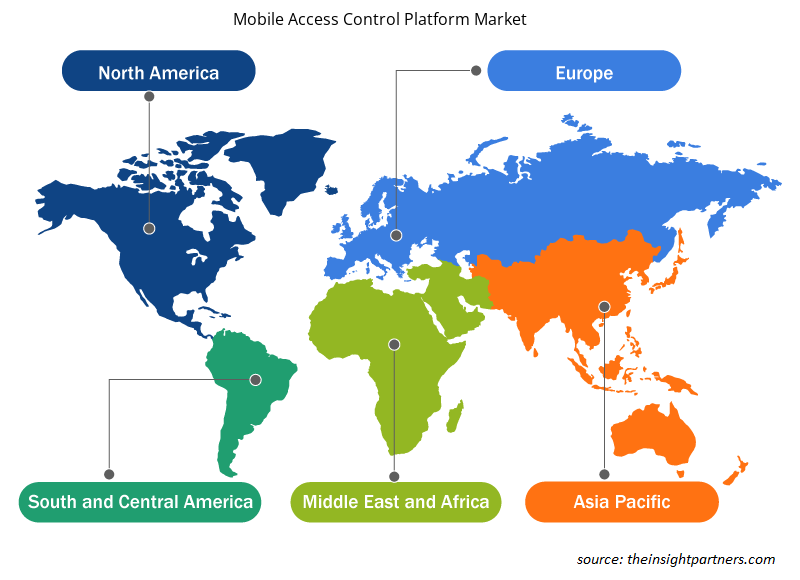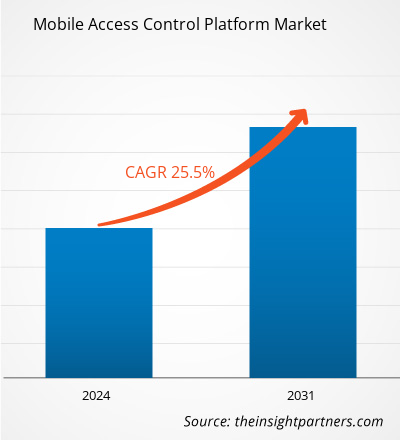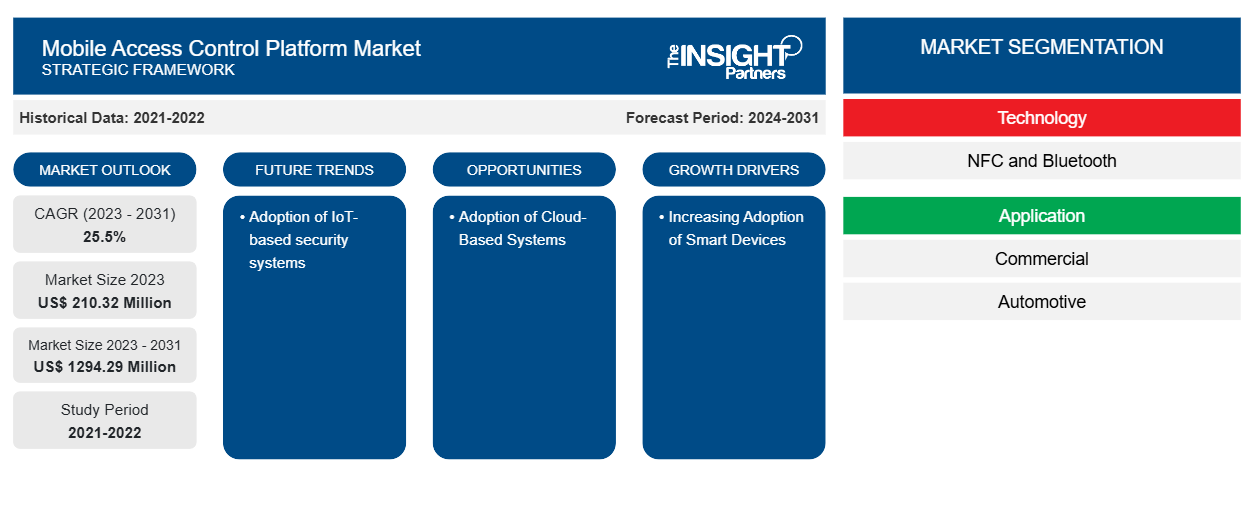Der globale Markt für mobile Zugangskontrollplattformen soll von 210,32 Millionen US-Dollar im Jahr 2023 auf 1294,29 Millionen US-Dollar im Jahr 2031 wachsen; von 2024 bis 2031 wird eine durchschnittliche jährliche Wachstumsrate von 25,5 % erwartet. Der zunehmende Einsatz drahtloser Sicherheitssysteme, steigende Kriminalitätsraten und die zunehmende Beliebtheit von Cloud-Computing-Plattformen werden voraussichtlich auch weiterhin die wichtigsten Trends auf dem Markt für mobile Zugangskontrollplattformen bleiben.
Marktanalyse für mobile Zugangskontrollplattformen
Die zunehmende Einführung IoT-basierter Sicherheitssysteme mit Cloud-Computing-Plattformen treibt den Markt für mobile Zugangskontrollplattformen voran.
Marktübersicht für mobile Zugangskontrollplattformen
Eine mobile Zugangskontrollplattform ist eine digitale Lösung, mit der Unternehmen den Zugang zu ihren Räumlichkeiten oder Ressourcen mithilfe mobiler Geräte verwalten und kontrollieren können. Diese Plattform nutzt die Leistungsfähigkeit von Smartphones und anderen Mobilgeräten, um eine sichere, bequeme und flexible Methode zum Erteilen und Entziehen von Zugangsberechtigungen bereitzustellen. Mit einer mobilen Zugangskontrollplattform können Unternehmen auf physische Schlüssel, Zugangskarten oder herkömmliche Zugangskontrollsysteme verzichten. Stattdessen können Mitarbeiter oder autorisierte Personen ihre Mobilgeräte wie Smartphones oder Tablets verwenden, um Zugang zu eingeschränkten Bereichen oder Ressourcen zu erhalten. Dies vereinfacht nicht nur den Zugangsprozess, sondern erhöht auch die Sicherheit, indem das Risiko verlorener oder gestohlener Schlüssel oder Karten verringert wird. Die Plattform besteht normalerweise aus einer mobilen App und einem Cloud-basierten Backend-System. Die App fungiert als digitaler Berechtigungsnachweis, der einfach heruntergeladen und auf den Mobilgeräten autorisierter Benutzer installiert werden kann. Das in der Cloud gehostete Backend-System ermöglicht Administratoren die Verwaltung von Zugangsberechtigungen, die Überwachung von Zugangsereignissen und die Erstellung von Berichten.
Passen Sie diesen Bericht Ihren Anforderungen an
Sie erhalten kostenlos individuelle Anpassungen an jedem Bericht, einschließlich Teilen dieses Berichts oder einer Analyse auf Länderebene, eines Excel-Datenpakets sowie tolle Angebote und Rabatte für Start-ups und Universitäten.
-
Holen Sie sich die wichtigsten Markttrends aus diesem Bericht.Dieses KOSTENLOSE Beispiel umfasst eine Datenanalyse von Markttrends bis hin zu Schätzungen und Prognosen.
Markttreiber und Chancen für mobile Zugangskontrollplattformen
Zunehmende Verbreitung von Smart Devices begünstigt den Markt
Die Nutzung von Smart-Geräten und IoT-Technologie (Internet of Things) nimmt zu, und dieser Trend treibt das Wachstum des Marktes für mobile Zutrittskontrolle voran. Smart-Geräte, die die Grundschicht des IoT-Technologie-Stacks bilden, verzeichnen ein gesundes Marktwachstum. Große Hersteller und spezialisierte Anbieter dominieren sie. Die Nutzung von IoT-Technologie nimmt in einer Vielzahl von Branchen zu, darunter Industrie 4.0, Smart Cities, Smart Homes , vernetzte Autos und E-Health. Insbesondere der kommerzielle und industrielle Sektor wird voraussichtlich das Wachstum des Marktes für mobile Zutrittskontrolle vorantreiben. Unternehmen im Einzelhandel beispielsweise setzen aktiv Lot-Projekte um, wobei mindestens 58 % mehrere aktuelle Lot-Initiativen haben. Viele Geschäfte ergreifen auch Initiativen, um den Datenschutz zu stärken und Datenschutzverletzungen zu vermeiden. Darüber hinaus wächst der Markt für umweltbezogene Lot-Systeme wie Umweltsensor- und -überwachungstechnologien rasant.IoT (Internet of Things) technology is on the rise, and this trend is driving the growth of the mobile access control market. Smart devices, which form the foundational layer of the IoT technology stack, are experiencing healthy market growth. Large manufacturers and specialist suppliers dominate them. IoT technology usage is growing across a wide range of industries, including Industry 4.0, smart cities, smart
Einführung Cloud-basierter Systeme
Cloud-basierte Lösungen haben in den letzten Jahren an Popularität gewonnen und dieser Trend wird den Markt voraussichtlich auch weiterhin antreiben. Cloud-Plattformen ermöglichen Unternehmen eine effizientere Verwaltung von Zugangskontrollsystemen. Das bedeutet, dass Unternehmen einfach verwalten können, wer Zugriff auf ihre Systeme und Daten hat, was zu verbesserter Sicherheit und Compliance führt. Cloud-Plattformen ermöglichen Unternehmen Skalierung und mehr Flexibilität. Unternehmen, die Cloud-basierte Technologien verwenden, können ihre Ressourcen je nach Bedarf einfach nach oben oder unten skalieren. Diese Flexibilität ermöglicht es Unternehmen, auf sich ändernde Geschäftsanforderungen zu reagieren und steigende Arbeitslasten zu bewältigen, ohne große Infrastrukturausgaben zu tätigen.
Segmentierungsanalyse des Marktberichts für mobile Zugangskontrollplattformen
Schlüsselsegmente, die zur Ableitung der Marktanalysetechnologie und -anwendung für mobile Zugriffskontrollplattformen beigetragen haben.
- Basierend auf der Technologie ist der Markt in NFC und Bluetooth unterteilt. Das NFC-Segment hatte im Jahr 2023 einen größeren Marktanteil.
- Basierend auf der Anwendung ist der Markt in Gewerbe, Automobil und Sonstiges unterteilt. Das gewerbliche Segment hatte im Jahr 2023 einen größeren Marktanteil.
Marktanteilsanalyse für mobile Zugangskontrollplattformen nach geografischen Gesichtspunkten
Der geografische Umfang des Marktberichts für mobile Zugangskontrollplattformen ist hauptsächlich in fünf Regionen unterteilt: Nordamerika, Asien-Pazifik, Europa, Naher Osten und Afrika sowie Südamerika/Süd- und Mittelamerika. Nordamerika dominierte den Markt für mobile Zugangskontrollplattformen im Jahr 2023. Technologische Fortschritte wie der Einsatz von drahtloser Technologie, Cloud- Computing -Plattformen und IoT-basierten Sicherheitssystemen treiben das Wachstum des Marktes für mobile Zugangskontrollplattformen voran. Diese Fortschritte verbessern die Effizienz, den Komfort und die Effektivität von Zugangskontrollsystemen.
Regionale Einblicke in den Markt für mobile Zugangskontrollplattformen
Die regionalen Trends und Faktoren, die den Markt für mobile Zugangskontrollplattformen im Prognosezeitraum beeinflussen, wurden von den Analysten von Insight Partners ausführlich erläutert. In diesem Abschnitt werden auch die Marktsegmente und die Geografie mobiler Zugangskontrollplattformen in Nordamerika, Europa, im asiatisch-pazifischen Raum, im Nahen Osten und Afrika sowie in Süd- und Mittelamerika erörtert.

- Erhalten Sie regionale Daten zum Markt für mobile Zugangskontrollplattformen
Umfang des Marktberichts zur mobilen Zugangskontrollplattform
| Berichtsattribut | Details |
|---|---|
| Marktgröße im Jahr 2023 | 210,32 Millionen US-Dollar |
| Marktgröße bis 2031 | 1294,29 Millionen US-Dollar |
| Globale CAGR (2023 - 2031) | 25,5 % |
| Historische Daten | 2021-2022 |
| Prognosezeitraum | 2024–2031 |
| Abgedeckte Segmente |
Nach Technologie
|
| Abgedeckte Regionen und Länder |
Nordamerika
|
| Marktführer und wichtige Unternehmensprofile |
|
Marktteilnehmerdichte: Der Einfluss auf die Geschäftsdynamik
Der Markt für mobile Zugangskontrollplattformen wächst rasant, angetrieben durch die steigende Nachfrage der Endnutzer aufgrund von Faktoren wie sich entwickelnden Verbraucherpräferenzen, technologischen Fortschritten und einem größeren Bewusstsein für die Vorteile des Produkts. Mit steigender Nachfrage erweitern Unternehmen ihr Angebot, entwickeln Innovationen, um die Bedürfnisse der Verbraucher zu erfüllen, und nutzen neue Trends, was das Marktwachstum weiter ankurbelt.
Die Marktteilnehmerdichte bezieht sich auf die Verteilung von Firmen oder Unternehmen, die in einem bestimmten Markt oder einer bestimmten Branche tätig sind. Sie gibt an, wie viele Wettbewerber (Marktteilnehmer) in einem bestimmten Marktraum im Verhältnis zu seiner Größe oder seinem gesamten Marktwert präsent sind.
Die wichtigsten Unternehmen auf dem Markt für mobile Zugangskontrollplattformen sind:
- Kisi Inc.
- Idesco Oy
- YPTOKEY
- Nokia, Inc.
- Proxy, Inc.
- Unikey Technologies Inc.
Haftungsausschluss : Die oben aufgeführten Unternehmen sind nicht in einer bestimmten Reihenfolge aufgeführt.

- Überblick über die wichtigsten Akteure auf dem Markt für mobile Zugangskontrollplattformen
Marktnachrichten und aktuelle Entwicklungen zu mobilen Zugangskontrollplattformen
Der Markt für mobile Zugangskontrollplattformen wird durch die Erfassung qualitativer und quantitativer Daten nach Primär- und Sekundärforschung bewertet, die wichtige Unternehmensveröffentlichungen, Verbandsdaten und Datenbanken umfasst. Im Folgenden finden Sie eine Liste der Entwicklungen auf dem Markt:
- Im Mai 2023 kündigten Eagle Eye Networks, der weltweit führende Anbieter von Cloud-Videoüberwachung, und Brivo, der weltweit führende Anbieter von cloudbasiertem Zugangsmanagement und Smart Space-Technologie, eine der bedeutendsten Investitionen in die physische Cloud-Sicherheit an. SECOM CO., LTD, laut Forbes Global 2000 eines der weltweit größten Sicherheitsintegrationsunternehmen, hat eine primäre Kapitalbeteiligung von 192 Millionen US-Dollar in die beiden Unternehmen getätigt, davon 100 Millionen US-Dollar in Eagle Eye Networks und 92 Millionen US-Dollar in Brivo.
(Quelle: Brivo, Pressemitteilung, 2023)
Marktbericht zu mobilen Zugangskontrollplattformen – Umfang und Ergebnisse
Der Bericht „Marktgröße und Prognose für mobile Zugangskontrollplattformen (2021–2031)“ bietet eine detaillierte Analyse des Marktes, die die folgenden Bereiche abdeckt:
- Marktgröße und Prognose auf globaler, regionaler und Länderebene für alle wichtigen Marktsegmente, die im Rahmen des Projekts abgedeckt sind
- Marktdynamik wie Treiber, Beschränkungen und wichtige Chancen
- Wichtige Zukunftstrends
- Detaillierte PEST/Porters Five Forces- und SWOT-Analyse
- Globale und regionale Marktanalyse mit wichtigen Markttrends, wichtigen Akteuren, Vorschriften und aktuellen Marktentwicklungen
- Branchenlandschaft und Wettbewerbsanalyse, einschließlich Marktkonzentration, Heatmap-Analyse, prominenten Akteuren und aktuellen Entwicklungen
- Detaillierte Firmenprofile
- Historische Analyse (2 Jahre), Basisjahr, Prognose (7 Jahre) mit CAGR
- PEST- und SWOT-Analyse
- Marktgröße Wert/Volumen – Global, Regional, Land
- Branchen- und Wettbewerbslandschaft
- Excel-Datensatz
Aktuelle Berichte
Verwandte Berichte
Erfahrungsberichte
Grund zum Kauf
- Fundierte Entscheidungsfindung
- Marktdynamik verstehen
- Wettbewerbsanalyse
- Kundeneinblicke
- Marktprognosen
- Risikominimierung
- Strategische Planung
- Investitionsbegründung
- Identifizierung neuer Märkte
- Verbesserung von Marketingstrategien
- Steigerung der Betriebseffizienz
- Anpassung an regulatorische Trends























 Kostenlose Probe anfordern für - Markt für mobile Zugangskontrollplattformen
Kostenlose Probe anfordern für - Markt für mobile Zugangskontrollplattformen